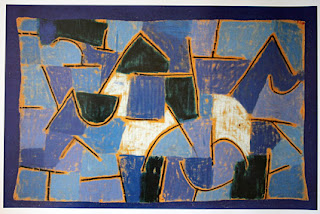 |
| Redgreen and Violet-Yellow Rhythms |
The
Tate Modern’s exhibition on Paul Klee: Making Visible might not quite be
exhaustive, but exhausting it most certainly is.
Laid
out in 17 rooms – some large, some small with only four or five pictures – it
takes a serious investment of time to visit.
As
a neighbour of ours, having visited with his partner, who is herself an artist,
commented with a note of weariness: “There are a lot of paintings”.
A
great deal of Klee’s work is also on small canvases, so require you to get up
close and use a little more attention.
By the time we reached the final rooms, visitors were scurrying past us having clearly had enough.
 |
| Battle Scene from the Comic-Fantastic Opera 'The Seafarer' |
That
being said, it’s an exhibition that offers plenty of rewards – not least in
providing such an extensive selection of his work, from 1912 to his premature
death in 1940.
In
the later part of that career, Klee – a Swiss German – was among the many
artists who were damned by the Nazis as ‘degenerate’.
Yet
for all Hitler’s hatred of anything beyond the most traditional painting,
Klee’s work has a timeless quality that can make it feel as ancient as it is
modern, and most definitely has something of folk art about it.
 |
| Blue Night |
There
is a playfulness on occasion and an apparently naïve joy about some of the
works that is reminiscent of Chagall.
Yet
there’s also plenty here to illustrate Klee’s seriousness – not least in his
explorations of colour.
The gradation paintings are themselves fascinating and
very beautiful and however muted some of his palette may appear to be, there is a depth of colour here that is vibrant and has great warmth.
 |
| Fish Magic |
The
experimentation extends beyond colour to the media used, including what was
painted on, how it was primed – and also how the works are displayed.
In
some cases, Klee made his own mounts and frames, thus ensuring that the works
take on a sense of having greater dimension and of being artistic objects
rather than simply being flat pictures.
Personally,
I was coming to Klee with little more than a spot of book-learned knowledge,
but found myself drawn in to some of the works in particular.
 |
| Walpurgis Night |
Redgreen
and Violet-Yellow Rhythms from
Perhaps
it’s the Christmassyness of the green and red, but getting lost in it conjures,
for me, a sense of a northern winter: of dark, starry nights and snowy terrain
and forests.
But
this sort of thing was a repeat theme.
In
Walpurgis Night, a gouache from 1935, the faces of creatures and witches
look out from behind the moody blue wood.
 |
| Bewitched-Petrified |
Here
we are again – into the realm of the forest in the German psyche. It has a
thrilling, slightly scary feel about it, and a sense of fairy tales, something
that comes through in a number of works.
Bewitched-Petrified (watercolour on
plywood, 1934) is another with the sense of folk/fairy tales and the forest.
Fish
Magic
(oil and watercolour on canvas, 1925) is one of the larger pieces, and seems to
have an inner glow, as though it’s partly stained glass, lit from behind.
Blue
Night
(1937) is a lovely, soothing use of colour and shape – no matter how apparently
loosely sketched the latter is in this instance.
It’s
also a good illustration of what I mentioned earlier about media. In this case,
it’s a “pastel on cotton on coloured paste on burlap; original frame”.
 |
| The Path into the Blue |
The
Path into the Blue (1934) appealed too: again, it’s a simplicity that allows
the imagination full rein.
Oh, and it’s got a blue moon in it, which had The
Other Half rolling his eyes as I (quietly) burst into the opening refrain of
Manchester City’s anthem.
Of
the more abstract works, I also liked The Invention (watercolour on cotton
on plywood, 1934) and, quite differently, The Other Half particularly liked Still
Life with Crucifers (oil on linen on cardboard, 1925).
 |
| Still life with Crucifers |
Of
the fantastical and the fairy tale, Battle Scene from the Comic-Fantastic
Opera ‘The Seafarer’ (oil, graphite, watercolour and gouache on paper, bordered
with watercolour, ink and gouache on cardboard, 1923) has it by the bucketload.
Comedy (watercolour and oil
transfer drawing on paper, 1921) is just one more example of many with a
playful and yet strange quality about it.
It
was Klee himself who said that drawing was “taking a line for a walk”.
The
Tate’s exhibition, which is on until March, offers a pefect opportunity to take
the eyes for a walk and let the imagination run wild.
Just don’t expect to see it in anything less than an hour and a half.
No comments:
Post a Comment